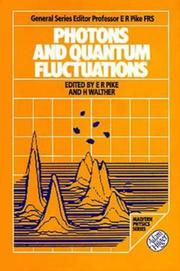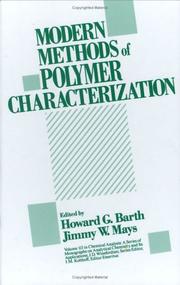| Listing 1 - 10 of 13 | << page >> |
Sort by
|
Book
ISBN: 3031643348 Year: 2025 Publisher: Cham, Switzerland : Springer,
Abstract | Keywords | Export | Availability | Bookmark
 Loading...
Loading...Choose an application
- Reference Manager
- EndNote
- RefWorks (Direct export to RefWorks)
This book covers the latest trends in the design of single-photon avalanche diodes (SPADs), which are the front-end sensors in modern photon counting systems. The authors describe the fundamental physics that enable photon counting in these devices. They also discuss systems that are made from these detectors, specifically describing circuit architectures that may be used to achieve high-fidelity photon counting. Coverage features example devices and systems designed in the authors’ research groups as well as different approaches undertaken by other experts in the field. The authors take a unique, modular approach that covers every aspect of the design stack, with stand-alone chapters, allowing readers to focus on specific aspects of the technology stack. Coverage includes the device-physics aspects of the detectors, their integration in modern electronics fabrication technologies like CMOS, and application-specific systems that utilize these detectors. Covers the latest trends in the design of single-photon avalanche diodes (SPADs); Takes a unique approach that covers every aspect of the design stack; Guides readers through implementing experimental test beds for device and system characterization projects.
Book
ISBN: 0387117962 Year: 1983 Publisher: Berlin Springer
Abstract | Keywords | Export | Availability | Bookmark
 Loading...
Loading...Choose an application
- Reference Manager
- EndNote
- RefWorks (Direct export to RefWorks)
Fluid mechanics --- Photon correlation --- Congresses --- Congresses
Book
ISBN: 0125241402 0323141447 1299252680 Year: 1984 Publisher: London Academic Press
Abstract | Keywords | Export | Availability | Bookmark
 Loading...
Loading...Choose an application
- Reference Manager
- EndNote
- RefWorks (Direct export to RefWorks)
Theoretical spectroscopy. Spectroscopic techniques --- fysicochemie --- Fluorescence --- Photon correlation --- Photons --- Corrélation --- Fluorescence. --- Corrélation. --- Corrélation.
Book
ISBN: 0306357038 1461589088 1461589061 Year: 1974 Volume: v. 3 Publisher: New York, N.Y. Plenum Press
Abstract | Keywords | Export | Availability | Bookmark
 Loading...
Loading...Choose an application
- Reference Manager
- EndNote
- RefWorks (Direct export to RefWorks)
Biological techniques --- Theoretical spectroscopy. Spectroscopic techniques --- fysicochemie --- Fluid mechanics --- Light --- Photon correlation --- Light beating spectroscopy --- Lumière --- Scattering --- Congresses --- Diffusion --- Congrès --- -Light beating spectroscopy --- -Photon correlation --- -535 --- Correlation, Photon --- Quantum electrodynamics --- Quantum optics --- Spectrum analysis --- Photon correlation spectroscopy --- Spectroscopy, Light beating --- Spectroscopy, Photon correlation --- Laser spectroscopy --- Electromagnetic waves --- Light sources --- -Congresses --- Optics --- 535 Optics --- Lumière --- Congrès --- 535 --- Scattering&delete& --- Congresses.

ISBN: 0852742401 Year: 1988 Publisher: Bristol Hilger
Abstract | Keywords | Export | Availability | Bookmark
 Loading...
Loading...Choose an application
- Reference Manager
- EndNote
- RefWorks (Direct export to RefWorks)
Optics. Quantum optics --- Quantum optics --- Photon correlation --- -Quantum optics --- -Optics --- Photons --- Quantum theory --- Correlation, Photon --- Light --- Quantum electrodynamics --- Spectrum analysis --- Congresses --- Scattering --- -Congresses

ISBN: 0471828149 Year: 1991 Volume: vol 113 Publisher: New York, NY : John Wiley,
Abstract | Keywords | Export | Availability | Bookmark
 Loading...
Loading...Choose an application
- Reference Manager
- EndNote
- RefWorks (Direct export to RefWorks)
Presents the methods used for characterization of polymers. In addition to theory and basic principles, the instrumentation and apparatus necessary for methods used to study the kinetic and thermodynamic interactions of a polymer with its environment are covered in detail. Some of the methods examined include polymer separations and characterization by size exclusion and high performance chromatography, inverse gas chromatography, osmometry, viscometry, ultracentrifugation, light scattering and spectroscopy.
Polymers --- Analysis. --- Analysis --- Polymers - Analysis. --- POLYMERS --- CHROMATOGRAPHY --- CHEMICAL CHAINS --- FRACTIONATION --- VISCOSITY --- ULTRACENTRIFUGATION --- NUCLEAR MAGNETIC RESONANCE --- MASS SPECTROMETRY --- LASER RADIATION SCATTERING --- PHOTON-CORRELATION SPECTROSCOPY --- OSMOSIS --- ANALYSIS
Book
ISBN: 0306357232 1475716702 1475716680 Year: 1977 Volume: vol 23 Publisher: New York Plenum
Abstract | Keywords | Export | Availability | Bookmark
 Loading...
Loading...Choose an application
- Reference Manager
- EndNote
- RefWorks (Direct export to RefWorks)
Optics. Quantum optics --- Laser Doppler velocimeter --- -Photon correlation --- -535 --- Correlation, Photon --- Light --- Quantum electrodynamics --- Quantum optics --- Spectrum analysis --- Anemometer, Laser --- Doppler velocimeter, Laser --- Flowmeter, Laser --- Laser anemometer --- Laser flowmeter --- Velocimeter, Laser Doppler --- Fluid dynamic measurements --- Congresses --- Optics --- Scattering --- 535 Optics --- Photon correlation --- 535
Book
ISBN: 047187289X Year: 1983 Publisher: New York
Abstract | Keywords | Export | Availability | Bookmark
 Loading...
Loading...Choose an application
- Reference Manager
- EndNote
- RefWorks (Direct export to RefWorks)
Light beating spectroscopy --- Light --- Optical measurements --- Particle size determination --- Dispersion analysis --- Particles --- Soils --- Physical measurements --- Photon correlation spectroscopy --- Spectroscopy, Light beating --- Spectroscopy, Photon correlation --- Laser spectroscopy --- Quantum optics --- Spectrum analysis --- Light scattering --- Scattering of light --- Diffusion --- Reflection (Optics) --- Refraction --- Scattering (Physics) --- Scattering --- Testing --- Measuring methods in physics --- Surface chemistry --- Theoretical spectroscopy. Spectroscopic techniques --- Materials sciences --- fysicochemie
Book
ISBN: 0121990508 Year: 1975 Publisher: New York
Abstract | Keywords | Export | Availability | Bookmark
 Loading...
Loading...Choose an application
- Reference Manager
- EndNote
- RefWorks (Direct export to RefWorks)
Theoretical spectroscopy. Spectroscopic techniques --- fysicochemie --- 535 --- Optics --- Light beating spectroscopy. --- Light --- Photons --- Statistical mechanics. --- Scattering. --- Measurement. --- 535 Optics --- Light beating spectroscopy --- Statistical mechanics --- Mechanics --- Mechanics, Analytic --- Quantum statistics --- Statistical physics --- Thermodynamics --- Light quantum --- Einstein-Podolsky-Rosen experiment --- Light scattering --- Scattering of light --- Diffusion --- Particles --- Reflection (Optics) --- Refraction --- Scattering (Physics) --- Photon correlation spectroscopy --- Spectroscopy, Light beating --- Spectroscopy, Photon correlation --- Laser spectroscopy --- Quantum optics --- Spectrum analysis --- Scattering --- Measurement

ISBN: 0792347366 9401063559 9401155860 Year: 1997 Volume: 40 Publisher: Dordrecht : Kluwer,
Abstract | Keywords | Export | Availability | Bookmark
 Loading...
Loading...Choose an application
- Reference Manager
- EndNote
- RefWorks (Direct export to RefWorks)
Since their inception more than 2.5 years ago, photon correlation techniques for the spatial, temporal or spectral analysis of fluctuating light fields have found an ever-widening range of applications. Using detectors which re spond to single quanta of the radiation field, these methods are intrinsically digital in natnre and in many experimental situations offer a unique degree of accuracy and sensitivity, not only for the study of primary light sources themselves, but most particularly in the use of a laser-beam probe to study light scattering from pure fluids, macromolecular suspensions and laminar or turbulent flowing fluids and gases. Following the earliest developments in laser scattering by dilute macro nl01ecular suspensions, in , ... hich particle sizing was the main aim, and the use of photon correlation techniques for laser-Doppler studies of flow and tnrbuence. both of which areas were the subject of NATO ASls in Capri, Italy in 19;:3 and 19;6. significant advances have be('n made in recent years in many other areas. These were reflected in the topics covered in this NATO Advanced Research Workshop, which took place from August 2;th to 30th, 1!)!}6, at the Jagiellonian University, Krakow, Poland. These in cluded ('xperimental techniques. statist.ics and data reduction, colloids and aggregation, polymers, gels, liquid crystals and mixtures, protein solutions, critical pllf'nomena and dense media.
Light beating spectroscopy --- Congresses --- Light --- Scattering --- Optics. --- Electrodynamics. --- Lasers. --- Photonics. --- Physical chemistry. --- Analytical chemistry. --- Condensed matter. --- Classical Electrodynamics. --- Optics, Lasers, Photonics, Optical Devices. --- Physical Chemistry. --- Analytical Chemistry. --- Condensed Matter Physics. --- Condensed materials --- Condensed media --- Condensed phase --- Materials, Condensed --- Media, Condensed --- Phase, Condensed --- Liquids --- Matter --- Solids --- Analysis, Chemical --- Analytic chemistry --- Chemical analysis --- Chemistry, Analytic --- Chemistry --- Chemistry, Theoretical --- Physical chemistry --- Theoretical chemistry --- New optics --- Optics --- Light amplification by stimulated emission of radiation --- Masers, Optical --- Optical masers --- Light amplifiers --- Light sources --- Optoelectronic devices --- Nonlinear optics --- Optical parametric oscillators --- Dynamics --- Physics --- Photon correlation spectroscopy --- Spectroscopy, Light beating --- Spectroscopy, Photon correlation --- Laser spectroscopy --- Quantum optics --- Spectrum analysis --- COLLOIDS --- LIGHT SCATTERING --- POLYMERS --- GELS --- LIQUID CRYSTALS --- DATA PROCESSING --- PHASE SEPARATION --- CRITICAL PHENOMENA --- PROPERTIES
| Listing 1 - 10 of 13 | << page >> |
Sort by
|

 Search
Search Feedback
Feedback About UniCat
About UniCat  Help
Help News
News